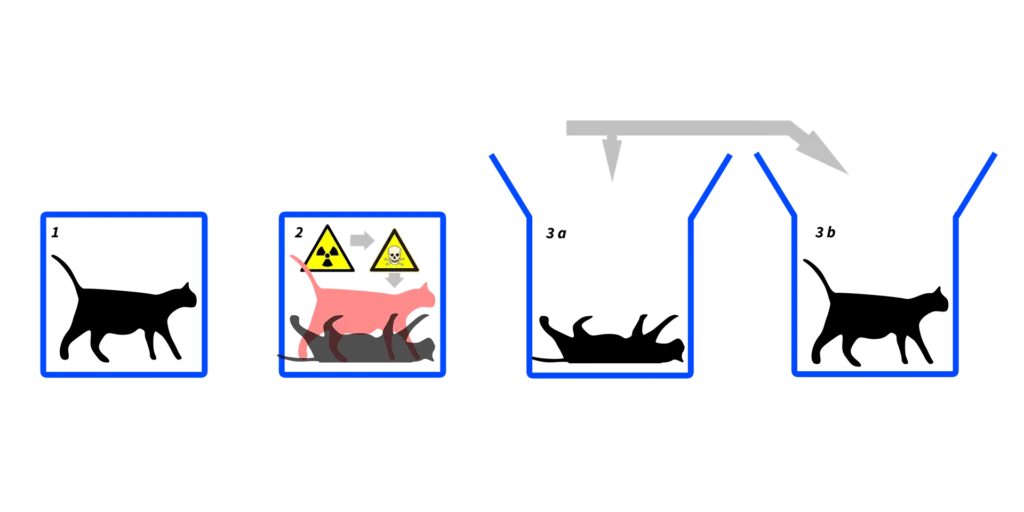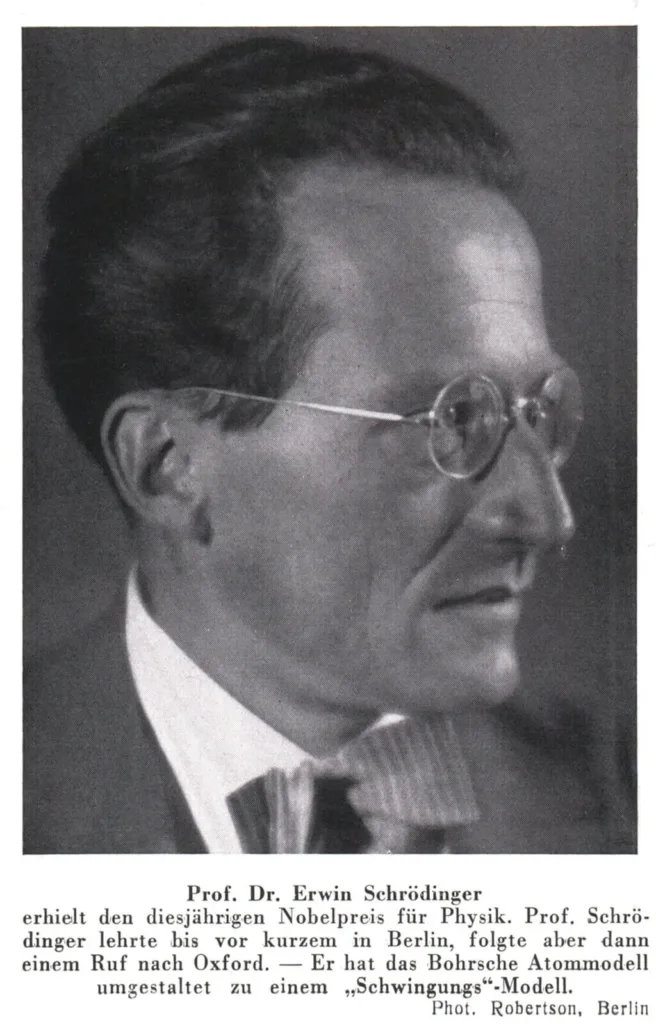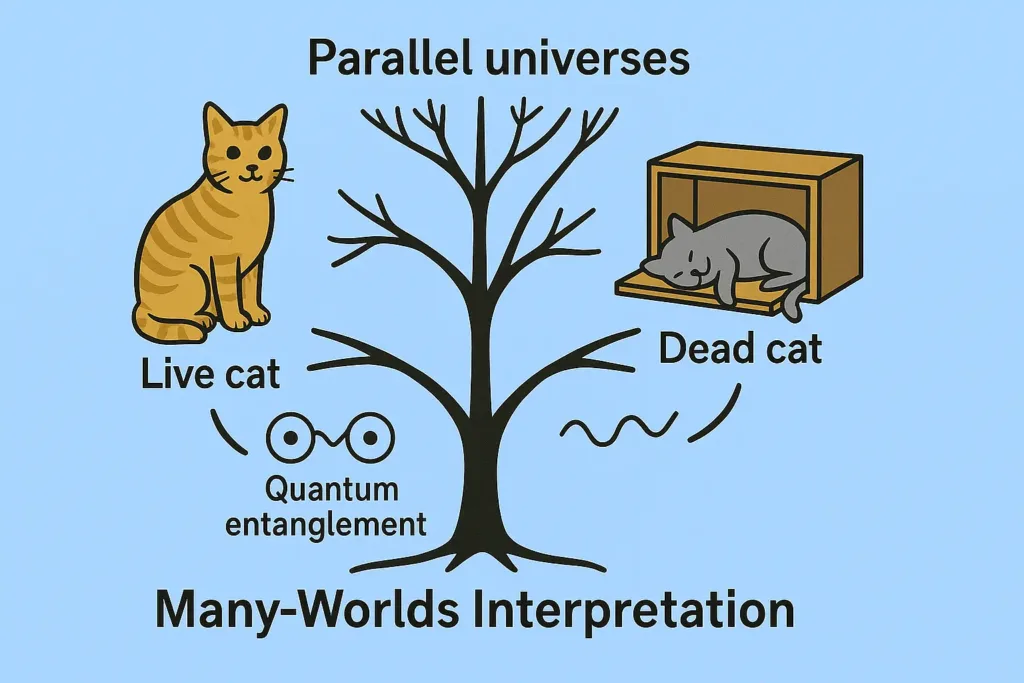If your friend told you that I was in two places at the same time last evening, what would be your response? This same situation occurs when we read that a cat can be alive and dead at the same time. This is explained in the Schrödinger’s cat thought experiment. This topic is considered one of the most famous experiments in quantum physics.
In 1935, the famous Austrian physicist Erwin Schrödinger conducted this experiment, which is why the experiment was named Schwanger’s Cat Thought Experiment. This paradox has baffled students, challenged scientists, and sparked countless debates for nearly 90 years. But the point is, the experiment was never intended to celebrate quantum mechanics. It was designed to expose what Schrödinger saw as its fundamental illogical nature.
Today we’ll take a step-by-step look at this well-known riddle. We’ll learn why a Nobel Prize-winning scientist created a difficult situation with a cat that might be in danger. Most importantly, you’ll see what this idea shows us about the strange nature of reality.
What is the Schrödinger’s Cat Thought Experiment?
Let’s start with the basics. Schrödinger’s Cat is a thought experiment that looks like the setup of a sci-fi movie. It’s a classic thought experiment, designed to explore the implications of quantum theory when applied to the everyday world.
Here’s how it works:
Consider a steel box, completely sealed so that you can’t see what is inside. Inside this box, you’ll have:
- One living cat
- A radioactive atom with a 50% chance of decaying within one hour
- A Geiger counter that detects radioactive decay
- A hammer connected to the Geiger counter
- A flask of deadly poison
The setup is arranged in a specific way. If the radioactive material decays, the Geiger counter will detect it, causing the hammer to break the flask and release the poison that kills the cat. If the atom does not decay, the flask remains intact, and the cat remains alive.

After one hour, two possible outcomes exist:
- The atom decayed → Geiger counter activated → Hammer smashed flask → Cat is dead
- The atom didn’t decay → Nothing happened → Cat is alive
It seems like a fairly easy process, doesn’t it? But this is the point where things get weird.
The Central Paradox of Quantum Superposition

The most important consequence of Schrödinger’s cat experiment is quantum superpositions. This is a principle according to which small particles can exist in multiple states at the same time. I can give you an example of this by tossing a coin in the air. It is spinning in the air. Its position can be heads or tails at the same time until the coin falls to the ground. Similarly, when we consider particles at the atomic level, they don’t behave like our everyday objects. They follow rules that defy common sense. For example, an electron’s spin can be both up and down. A photon can take multiple paths through a double-slit experiment. These paths create interference patterns that prove superposition exists. The atom’s wave function describes all possible states it can occupy.
This idea was closely linked to the Copenhagen interpretation. It was the most widely accepted explanation of quantum mechanics given by Niels Bohr in the 1930s. According to this theory, the act of observation causes the wave function (the mathematical description of a quantum system) to collapse into a definite state. In other words, before we open the box, the cat’s wave function includes both life and death. The moment we look, the wave function collapses, and we see either a living cat or a dead one.
This is the point where the contradiction becomes clear, because in our daily lives, macroscopic objects like cats can’t behave like quantum objects. They do not exist in the realm of the supernatural, which depends on human observation. Schrödinger’s point was that the extension of quantum rules to a large scale leads to absurdity. It creates a contradiction between quantum physics and classical intuition. Beginners who want a clear introduction to this idea should read “In Search of Schrödinger’s Cat” by John Gribbin. I myself highly rate this book because this book explains the paradox in an easy way.
Why Schrödinger Criticized Quantum Mechanics?

You might be surprised to learn that Schrödinger’s cat was not intended to prove anything about cats, but rather to highlight what Schrödinger and his close friend Albert Einstein saw as a major flaw in the Copenhagen interpretation. Schrödinger, like Albert Einstein, was deeply skeptical of the idea that observation alone determines reality. Both scientists felt that quantum mechanics, while mathematically successful, was incomplete as an explanation of the physical world. Einstein famously complained that “God doesn’t play dice with the universe,” showing his discomfort with the randomness at the core of quantum theory. Schrödinger’s cat took this skepticism a step further by showing how funny things get when quantum rules are extended to the macroscopic world.
By introducing a cat into the experiment, Schrödinger dramatically illustrated the strangeness of the collapse of the wave function. If the Copenhagen interpretation was correct, then until the observation was made, the cat had no definite fate—it was suspended in the strange limbo of life and death. Schrödinger saw this as an advertisement for reductionism—a way of showing that quantum mechanics, as it was being interpreted, could not be the final word on reality.
This perspective is also connected to Schrödinger’s broader scientific work. He was one of the pioneers of quantum mechanics, best known for the Schrödinger equation, which mathematically describes how quantum systems evolve over time. Yet, even he struggled to reconcile the beauty of mathematics with the strange philosophical implications of observation and superposition.
Understanding the Problem with the Paradox in Quantum Mechanics
Modern physicists generally agree that Schrödinger’s cat is not a realistic explanation of how the quantum world interacts with the classical world. The cat is never in some mystical half-dead, half-alive state. I also think that the flaw lies in assuming that quantum superpositions simply extend from the microscopic to the macroscopic world without any extra factors.
This is where the concept of interaction comes into play. Decoherence describes how delicate quantum states interact with their environment. The moment a quantum system (such as an atom) becomes entangled with a larger system (such as a cat, air molecules in a box, or even a stray photon), the complex superposition collapses almost instantly. The system does not remain in a ghostly mixture of states. It naturally “collapses” through interaction with the environment. This happens long before any human observer opens the box.
So, while it is true that an atom can exist in decayed and non-decayed states, that does not mean that the cat itself is on a true level of life and death. In practice, by the time the Geiger counter interacts with the atom, the interaction has already ensured there is really only one outcome. Certainly, by the time the cat’s life is on the line, the interaction has already ensured a definitive result. The cat is either dead or alive – we just don’t know which until we look.
For students, I would like to make a simple observation: try to hold a soap bubble in a room with air. Superpositions are like these fragile bubbles – they collapse quickly when disturbed. Decoherence is the “air” that makes it impossible to hold a superposition on a large scale.
Interpretations of the Schrödinger Paradox Beyond Copenhagen
Although decoherence offers a reasonable explanation for most physicists, but the question of what happens during measurement remains an interesting topic of debate. Specially for those who are not satisfied with the Copenhagen interpretation, other theories offer different solutions to the cat paradox.
1. The Many-Worlds Interpretation
One of the most popular alternatives is the many-worlds interpretation (MWI), first proposed by Hugh Everett in the 1950s. According to this theory, the universe does not “spread out” when measurements are made. Instead, every possible outcome actually exists, but we can’t see it all at once.

When it is applied to Schrödinger’s cat thought experiment, this means that when the box is opened, the universe splits:
- In one branch, the cat is alive.
- In another branch, the cat is dead.
We can see only one branch at a time, but both outcomes exist in parallel realities. While this interpretation seems like science fiction, it elegantly avoids the problem of wave function collapse – because nothing ever collapses. Instead, the universe continues to split into countless versions of itself.
2. Objective Collapse Theories
Some physicists argue that wave functions do not need observers or branching universes—they collapse on their own when they reach a certain level of complexity or mass. In these models, macroscopic objects like cats automatically have specific states. These theories aim to reconcile quantum mechanics with classical intuition, although they are speculative.
3. Pilot-Wave Theory (Bohmian Mechanics)
Another interesting interpretation is Bohmian mechanics, also known as pilot wave theory. Here, particles always have a specific position, guided by an invisible “pilot wave.” In this view, the cat is always either dead or alive—we just don’t know until we see it. The paradox disappears, albeit at the cost of reintroducing hidden variables into quantum mechanics.
The Broader Lesson of Schrödinger’s Cat
These interpretations highlight an important point: the paradox doesn’t just challenge physics, it challenges philosophy. Each explanation reflects a different worldview about reality, observation, and the role of humans in the universe. The Copenhagen interpretation is the most widely taught. However, Schrödinger’s cat continues to spark debate in classrooms. It is also discussed in conferences and even in science fiction.
What do you think, share in the comments.
The Legacy of the Schrödinger’s Cat Thought Experiment
Despite Schrödinger’s intention to criticize quantum mechanics, his thought experiment became a powerful educational tool and research inspiration.
1. The Measurement Problem
One advantage is that the paradox sheds light on the ongoing “measurement problem” of quantum physics. Scientists still debate when and why quantum superposition breaks down and definitive results emerge. This question is central to the study of quantum mechanics.
The observer effect—the idea that measurements affect quantum systems—continues to generate scientific inquiry. Researchers are working to understand whether consciousness plays a role in quantum measurements or if purely physical processes are sufficient.
2. Real-World Quantum “Cat States”
Scientists have created quantum states like Schrödinger’s cat in labs. These “cat states” show quantum superposition in large and complex systems.
Notable achievements include:
- Superconducting circuits existing in two current states simultaneously
- Photons in superposition of different polarization states
- Atoms in multiple energy levels at once
In 2012, scientists Serge Haroche and David Wineland won the Nobel Prize in Physics. They were recognized for creating and controlling small quantum systems. These systems are like real “cat states” with particles.
3. Impact on Quantum Computing
Thought experiments have greatly influenced the development of quantum computing. Quantum computers use quantum superpositions to execute multiple calculations at once. It is important to know how to keep and control superposition states without them breaking down too quickly. Schrödinger’s paradox helps scientists understand these problems.
Modern Applications of Schrödinger’s Cat in Science
Today, physicists are not just asking whether cats can be both dead and alive at the same time. They are now looking at their practical applications and deeper questions.
Quantum entanglement, which Einstein called “spooky action at a distance,” allows particles to influence each other instantaneously over long distances. It is now used in quantum communication and security.
However, some fundamental questions stay unanswered. The line between quantum behavior and regular behavior is not clear. Scientists are still trying to figure out where quantum effects stop and our usual experiments start.
The thought experiment of Schrödinger’s cat shows us that reality can be much stranger than it seems. Although we have resolved this paradox a lot, it has given rise to new quantum technologies that once seemed impossible.
Frequently Asked Questions
No one has done the exact experiment with a real cat because it was just an idea. But scientists have made similar “cat states” using particles, atoms, and small quantum systems that show the same ideas.
Einstein, who was also uncomfortable with quantum mechanics’ implications, appreciated Schrödinger’s criticism. He famously said quantum mechanics seemed incomplete and preferred theories where physical properties existed independently of observation.
While the original paradox is resolved through decoherence, it highlights ongoing debates about quantum measurement, the role of consciousness in physics, and the exact boundary between quantum and classical behavior.
At the quantum level, yes – particles can exist in superposition across multiple locations simultaneously. However, this effect disappears rapidly in larger, more complex systems due to environmental interactions.
Heisebberg’s uncertainty principle states that you can’t know both the position and speed of something exactly. In the cat example, this connects to the random way things decay, but Schrödinger made this idea more general in quantum mechanics.
Recommended Reads for Curious Minds
- Quantum Theory Cannot Hurt You by Marcus Chown
- Quantum: Einstein, Bohr and the Great Debate by Manjit Kumar
- The Fabric of Reality by David Deutsch
- Quantum Enigma: Physics Encounters Consciousness by Bruce Rosenblum and Fred Kuttner
Conclusion
Schrödinger’s cat thought experiment is a powerful teaching tool in science. Schrödinger created it to criticize quantum mechanics, but it helps us understand quantum ideas. We now know that a cat can’t be both dead and alive at the same time. In real life, living things quickly fall into distinct states due to randomness. However, the thought experiment reveals the strange idea of quantum superposition and the problems of applying quantum principles to everyday objects.
This paradox has led to new technologies such as quantum computers, secure quantum communication, and precise measurement devices. All of this comes from understanding quantum superposition and its limitations.
As we learn more about quantum technology, Schrödinger’s ideas are more important than ever. His thought experiment shows us that the universe works in ways that are very different from our everyday lives, which is exciting to learn about.
Want to test your knowledge of quantum physics? Try our interactive quiz and see how much you know about this extraordinary world where cats can be both dead and alive.





1 Comment
thanks for info.